ANEW is featured near the end of this excellent Retrofit Magazine article by Robert Nieminen
But while manufacturers forge ahead into the uncharted waters of new material health and specifiers jump onboard, what’s left in their wake? Answer: the potential for tremendous existing material waste. With more than 25 percent of existing buildings facing replacement by 2030, according to Environmental Building News (EBN), the amount of potentially discarded materials that will wind up in landfills is staggering.
Although the conversation about the relationship between new materials and human health is a vitally important one to engage in, ignoring the potential impact of reusing and repurposing existing building products, furniture, and finishes is shortsighted at best and negligent at worst. Consider the following statistics:
- Nearly 30 percent of all material consumption originates from building construction and nearly the same percentage of waste in U.S. landfills comes from construction demolition and debris, according to the 2010 report, “Design for Reuse Primer”, by Public Architecture, a national 501(c)(3) nonprofit based in San Francisco that engages architecture firms, nonprofits and manufacturers to commit to design for the public good.
- Building reuse almost always yields fewer environmental impacts than new construction, and savings from reuse are between 4 and 46 percent over new construction when comparing buildings with the same energy performance level, according to Seattle-based Preservation Green Lab’s 2011 study,“The Greenest Building: Quantifying the Environmental Value of Building Reuse”. (Preservation Green Lab advances research that explores the value older buildings bring to their communities and pioneers policy solutions that make it easier to reuse and green older and historic buildings.)
- According to Larry Strain, author of the EBN article, “Building Materials and the Time Value of Carbon”, we can reduce embodied emissions by around 30 percent by selecting existing materials and technology, by using lower-carbon materials, and by employing more-efficient design and construction processes.
 Additionally, LEED v4 rewards project teams that opt to reuse buildings and repurpose materials rather than specify new ones (as sustainable as they may be). Specifically, the Materials Reuse credit offers two to four possible points toward LEED certification for the reuse or salvaging of building materials from off-site or onsite, including structural elements (floors, roof decking); enclosure materials (skin, framing); and permanently installed interior elements, such as walls, doors, floor coverings and ceiling systems.
Additionally, LEED v4 rewards project teams that opt to reuse buildings and repurpose materials rather than specify new ones (as sustainable as they may be). Specifically, the Materials Reuse credit offers two to four possible points toward LEED certification for the reuse or salvaging of building materials from off-site or onsite, including structural elements (floors, roof decking); enclosure materials (skin, framing); and permanently installed interior elements, such as walls, doors, floor coverings and ceiling systems.
The new store melds REI’s rugged outdoor aesthetic with the storied building, featuring unique aspects, such as 30 stone printing tables from the early 1900s.
For building professionals who are considering renovations to their facilities, there’s nothing inherently more sustainable than extending the life of the existing materials. Here’s what they need to consider when planning for materials’ repurposing and reuse:
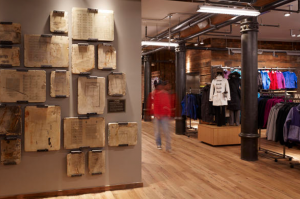
Extending the Life of Products
One of the challenges with reusing materials is that most building products and furnishings have not been designed for disassembly and reuse until very recently.
“The way the building space and the materials themselves are intentionally designed from an industrial design perspective, people aren’t always thinking about the entire life cycle of the product. Intentionally thinking about how those products are made and will be disassembled [is important],” explains Holley Henderson, LEED Fellow and founder of H2 Ecodesign, Atlanta.
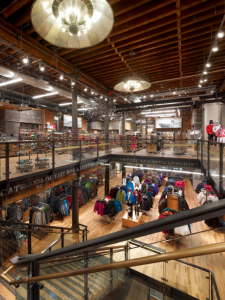 The good news for project teams is there are a number of product categories that lend themselves fairly effortlessly to salvage, including ceiling tiles, carpet tiles, furniture, metal studs, glazing, doors and plumbing fixtures—assuming they are in good condition, of course.
The good news for project teams is there are a number of product categories that lend themselves fairly effortlessly to salvage, including ceiling tiles, carpet tiles, furniture, metal studs, glazing, doors and plumbing fixtures—assuming they are in good condition, of course.
“Some of the easy ones [are] doors; door frames; hardware; flooring, such as carpet and carpet tile, primarily,” says Marcus Hopper, AIA, LEED ID+C, associate in Gensler’s San Francisco office. “If there’s existing millwork that’s in good shape, there is a benefit for reusing that just because it is costly sometimes to have to build that.”
Michael Gaffney, senior associate vice president at CallisonRTKL, Seattle, says the retail industry, in particular, is reusing a variety of materials rather than specifying new products. He notes: “We see a lot of our wood potentially being reused and can either be in place where a decision’s made to keep a wood floor, for instance, rather than stripping it out and replacing it. In terms of fixtures or furniture, what we’re seeing recently is the reuse of built-in fixtures as perimeter or dividing walls as opposed to completely tearing out an interior space and replacing it with all new millwork and fixtures or standard shelving.”
Gaffney adds lighting is another category that’s being increasingly reused thanks to new solutions that allow design teams to retrofit LED lamps into traditional fixtures.“Several manufacturers are coming out with LED retrofit lamps so we’re able to realize the benefits of long-term operational savings without having to sacrifice all of that capital upfront.We’re able to reuse the fixtures but put in new LED lamps.”
Taking Inventory and Making Assessments
Assuming a client wants to explore material reuse, among the first questions the design team will need to answer are which products can be salvaged and which ones will get recycled, discarded or donated, and what’s the best way to go about removing them?
Hopper says the design team has to consider those decisions in light of the overall scope of the project and design. Team members also will need to review the existing materials onsite to determine if they will work with the overall design they’re trying to achieve.
“It’s a very collaborative effort, so we’ll be working with the owner, the contractor, any other team members and as a team decide what to keep and what not to keep. Sometimes things we would like to keep, from a cost perspective, if it’s too costly to try to keep it just from a labor standpoint, it would be easier to just not use it in the project,” Hopper concedes.
Interior Designer Allie Trachsel, LEED AP ID+C, also in Gensler’s San Francisco office, says oftentimes the decision to reuse materials is an uncertain one because of variables that aren’t always immediately obvious. Nevertheless, the key stakeholders need to embark on the journey together.
“Sometimes you just don’t know,” she admits. “Do you make a decision as a team willing to jump into an exploration and not quite sure what the end product will be? It’s just something you decide with the team and move forward to deal with as the construction progresses.”
Although this approach may seem risky, what should not be left to chance is the issue of safety during product removal. Henderson points out manufacturers and fabricators need to consider end-of-life disassembly at the onset of design and think about things, such as lift points and other safety considerations, for removal later on.
“I think many times we just don’t think to that side of it,”Trachsel observes.“If we think about the product’s safety so it can be reused it’s very important to think about staging, transportation and handling, and writing plans around that, really.”
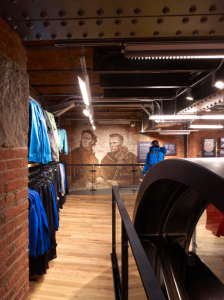 Another critical consideration for material removal and reuse is the issue of storage. If materials or furniture are deemed to be in good condition, the design team needs to develop a plan to relocate the materials where they can be housed safely during remodeling.
Another critical consideration for material removal and reuse is the issue of storage. If materials or furniture are deemed to be in good condition, the design team needs to develop a plan to relocate the materials where they can be housed safely during remodeling.
“Storage is big,” Hopper says. He recalls a recent project during which a client wanted to reuse some conference tables and placed them in storage for several months during the construction phase. The facility ended up losing the tables, which added unexpected costs to the project.
“If you’re going to reuse existing wood-plank flooring, for instance, it has to be removed, obviously, and stored somewhere it can be kept safe from damage, whether it’s impact-related or moisture-related or anything else that can happen to it during up to six months between when it’s removed and when it’s reinstalled,” Hopper suggests.
Ultimately, the key to successful removal and storage of materials comes down to effective communication across the design team.
“Close communication with the contractor to make sure they have clear instructions on how to preserve and protect the materials that are being reused or the things that are
in place so there’s no confusion around their responsibility during demolition and construction and to make sure things are preserved is key,” Gaffney explains.
Trachsel notes that at Gensler, internal communication is equally important in the quest for salvaged materials—not just among the design team members for one project, but across the entire firm. With anywhere from 40 to 50 projects going on at once, Trachsel says Gensler has been increasingly sharing information between project teams to take advantage of the existing materials at their disposal.
“If there’s building components that one team knows the project is going to remove, there may be another team that may need that building component and, being local, we can share the resource and say, ‘Hey, your project is right across the street from mine; let’s try
to communicate and see if we can have our teams move your material to my site’,” she says.
Counting the Costs
Reusing building materials and furnishings makes perfect sense environmentally speaking. What about financially? Are cost savings a given? It depends.
Hopper points to a recently completed project in which Gensler realized a 10 percent savings, totaling $70,000 overall—a significant portion of which can be attributed to material reuse and time and shipping costs that were avoided because materials were already onsite. “There’s definitely a cost savings,” he suggests.
Gaffney, on the other hand, says cost reductions aren’t always a given, nor do they always need to be. Sometimes, the story behind the materials and the legitimacy that comes along with “walking the talk” in terms of sustainability is as valuable to the client as the numbers.
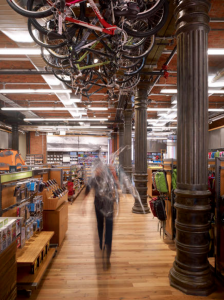 “I think when we talk about repurposing or retrofitting, people always assume that’s a big money saver and it’s not always the case,” Gaffney explains. “Breathing authenticity into a project by using actual materials from the world doesn’t always come as a cost savings from a capital expense standpoint. There’s not always a savings, but I would say, when there is, it’s not limited to the actual fixture.”
“I think when we talk about repurposing or retrofitting, people always assume that’s a big money saver and it’s not always the case,” Gaffney explains. “Breathing authenticity into a project by using actual materials from the world doesn’t always come as a cost savings from a capital expense standpoint. There’s not always a savings, but I would say, when there is, it’s not limited to the actual fixture.”
Material reuse is ultimately about the changing nature of the design and construction industry and the way people think about it. Just as there was initial pushback to waste-management diversion, Henderson says there’s a paradigm shift underway in terms of changing people’s thinking about salvaging materials.
Gaffney agrees:“The built environment and the way we treat our buildings and our interior spaces and the planet are all transforming. Our customers value brands that are conscious of that and are concerned about reusing things that are perfectly good, that may just need a little bit of a facelift to bring them up to like-new condition every consumer recognizes the value in. It’s a sensitivity to the customer and a sensitivity to the changing world.”
Donations: A Sustainable Approach to Surplus — ANEW
For organizations that decide not to reuse existing materials or furniture for their building projects but don’t want to send them to landfill, donating them is perhaps the best and most sustainable alternative.
“Today, tons of reusable surplus furniture and equipment enter our landfills. unfortunately, it’s an easy option at a very high environmental price,” explains Rose Tourje, founder and president of the 501(c) (3) non-profit ANEW, Los Angeles, which offers sustainable surplus stewardship solutions that include resale; recycling; and repurposing furniture, fixtures, and equipment and stewarding them to charities, non-profits, public agencies and underserved communities.
“Each time ANEW successfully matches a client’s surplus furnishings to a charity, the life cycle of those items is extended and given an encore to avoid landfill,” Tourje explains.
“We intercede and steward surplus to other non-profits, charity schools, police and fire stations, public agencies—people who can use it—that’s all within 25 miles of the donor company, so it stays in the community and represents a minimum carbon footprint,” explains Glenn Sparks, ANEW’s vice president. “During that [process], we divert over 2 million pounds per year from landfill. We strengthen communities, we help corporations significantly raise their CSR [Corporate Social Responsibility] and help them with community outreach.”
ANEW’s motto, doing what’s right with what’s left®, sums up the organization’s mission perfectly. In addition to the social component, donors receive critical documentation—such as tax receipts, diversion metrics and records toward meeting LEED certification—to comply with federal mandates for transparency and compliance, along with the power to revolutionize the disposal of office surplus.
Material Reuse in Action
PHOTOS: courtesy Gensler
The Natural Resources Defense Council’s San Francisco office renovation in the Financial District’s Hunter-Dulin building consisted of 15,000 square feet across the 20th and 21st floors. Because NRDC is an environmental organization, material reuse was naturally part of Gensler’s decision-making from the beginning.
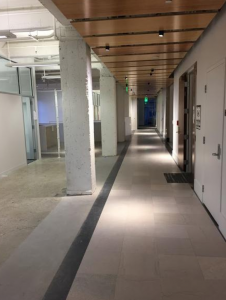
The existing bamboo ceiling panels and light fixtures will stay in place. Here Gensler focused its efforts on removing the existing carpet and, in doing so, unveiled the history and character of the building. Stone was discovered that connects from the historic elevator lobby at the circulation core.
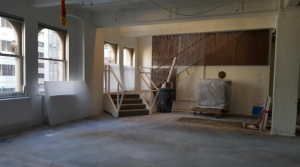
By moving the reception to the top of the stair, an open café was created, which will provide a central hub for all employees. The existing panels (shown installed at the stair) will be demolished, but their structural supports will be repurposed for new transparent metal screens.
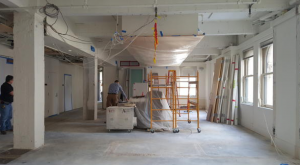
New sliding glass partitions (not shown) help open up the conference room to the connecting stair, creating a flexible central hub. Salvaged doors are stacked to the side for reuse in collaboration rooms and as tabletop materials. The existing bamboo ceiling panels are protected during construction.




